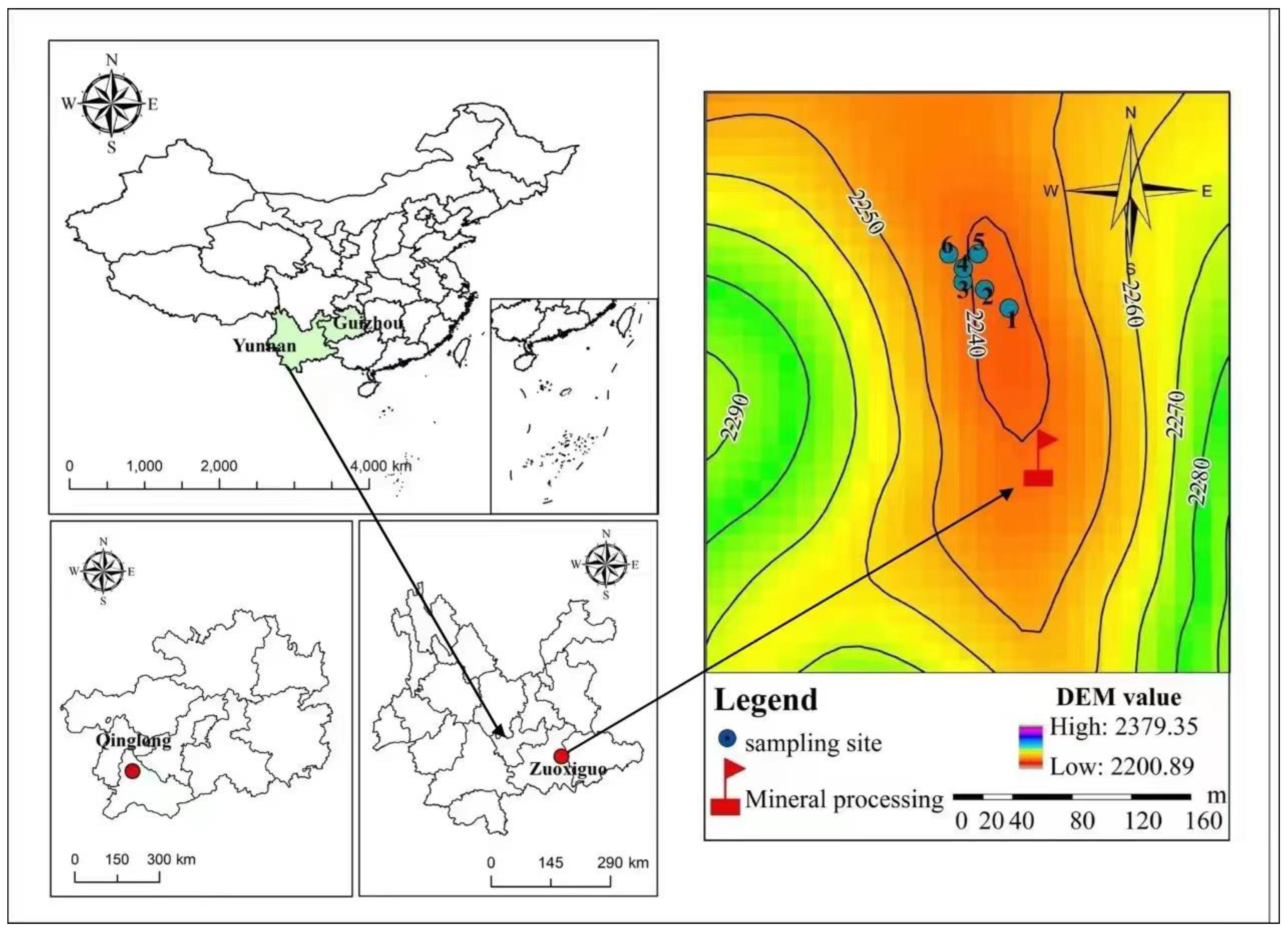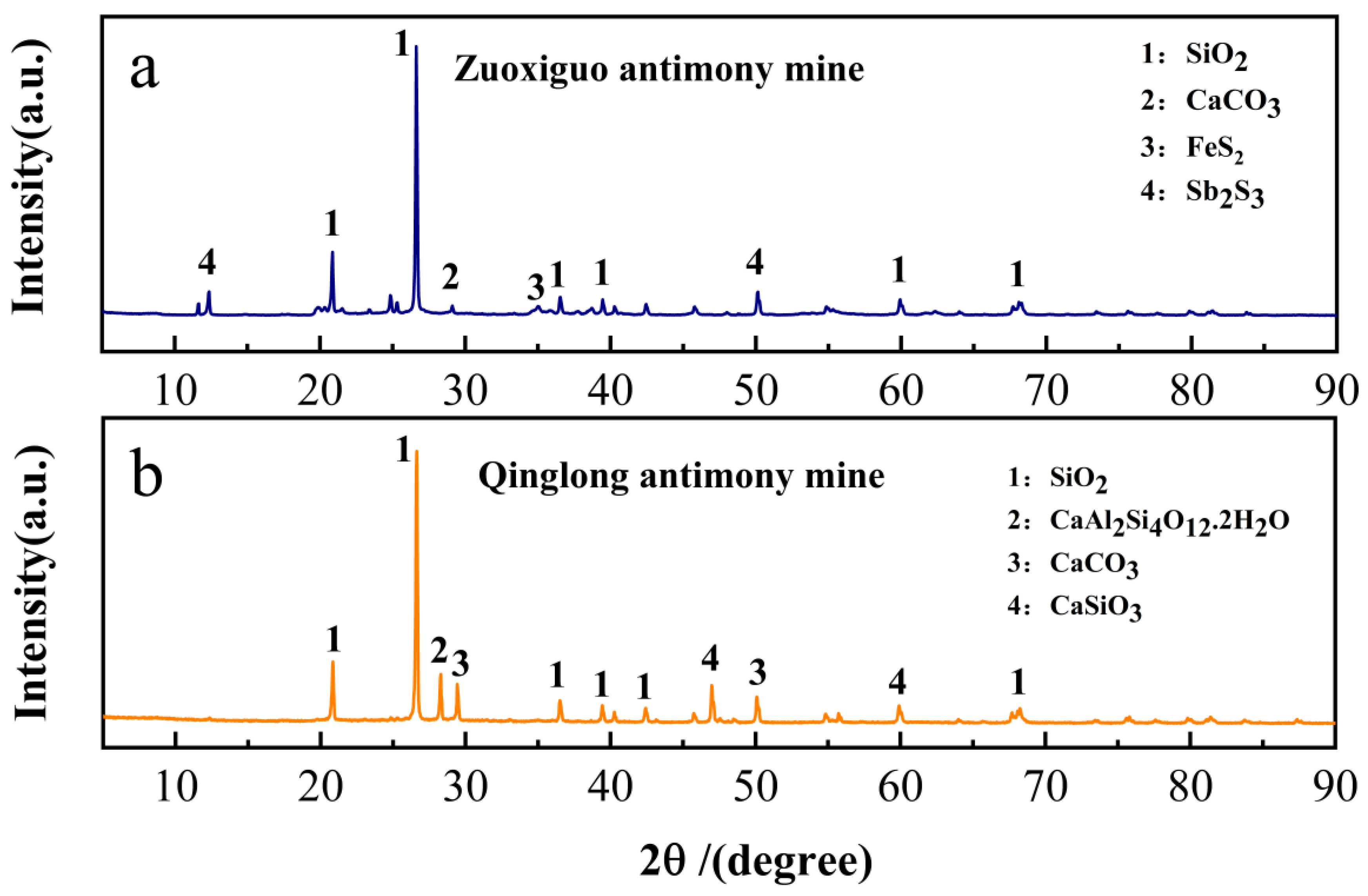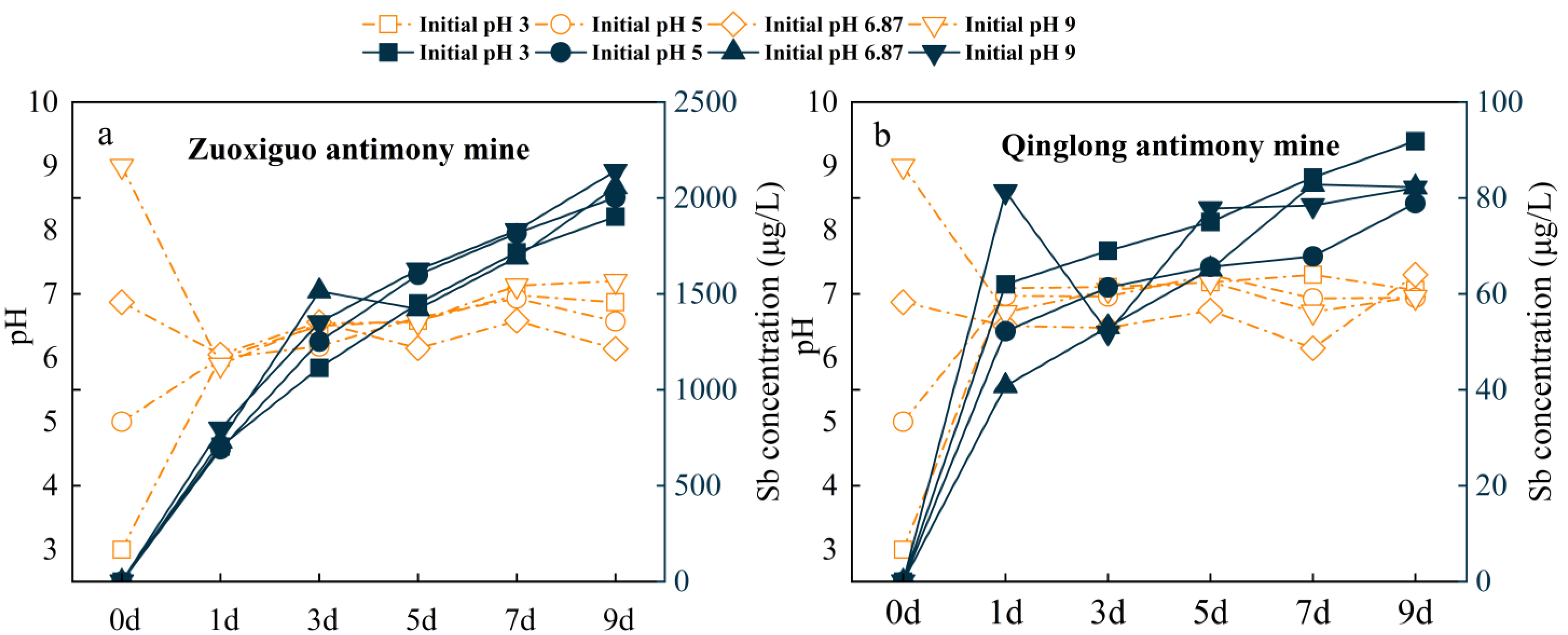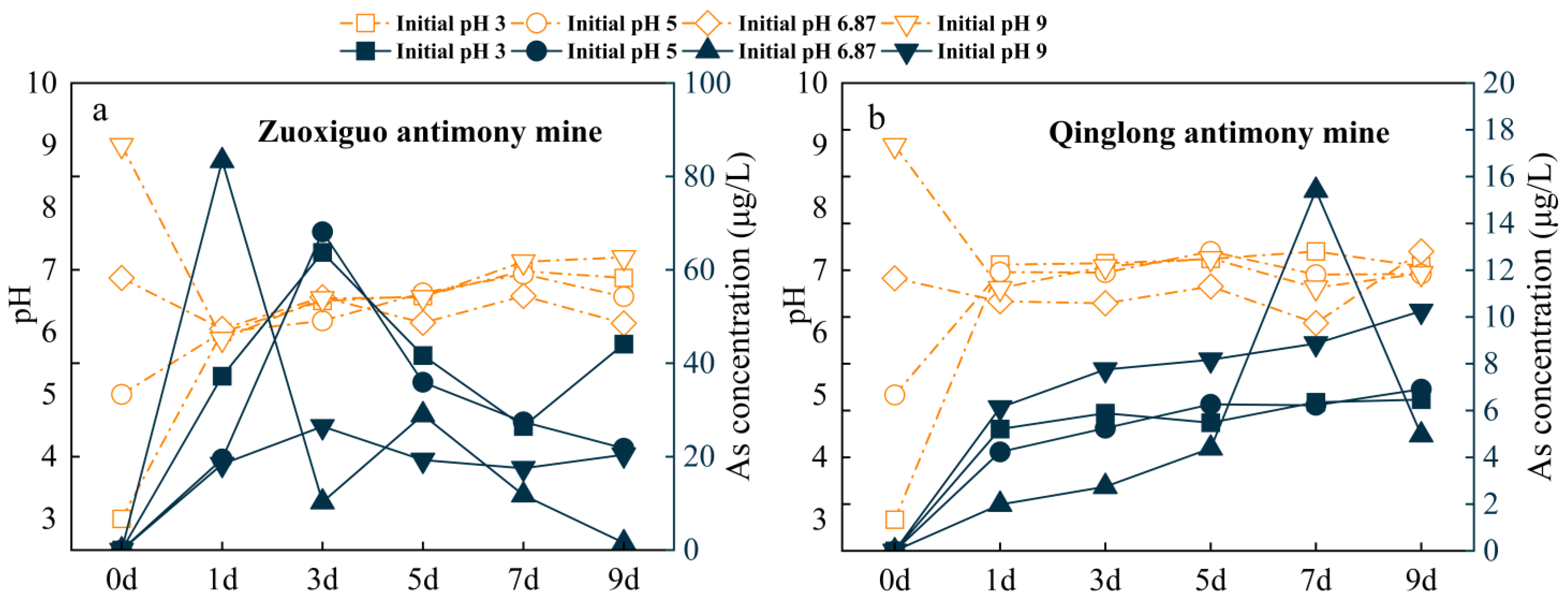Leaching Mechanism and Health Risk Assessment of As and Sb in Tailings of Typical Antimony Mines: A Case Study in Yunnan and Guizhou Province, Southwest China
Abstract
1. Introduction
2. Materials and Methods
2.1. Study Area
2.2. Sampling and Sample Preparation
2.3. Sequential Extraction and Leaching Test
2.4. Health Risk Assessment
2.4.1. Carcinogenic Risk Model
2.4.2. Non-Carcinogenic Risk Model
3. Results and Discussion
3.1. Mineral Composition and Toxic Elements Content in Tailings
3.2. Leaching Characteristics of Different Antimony Mining Tailings
Leaching Characteristics of Sb and As in Tailings, and pH Changes of Leachate during Leaching
3.3. Influence of Chemical Sb and As Species in Tailings on Leaching Mechanism
3.4. Surface Changing of Tailings during Leaching
3.5. Health Risk Assessment of Leachate
4. Conclusions
Author Contributions
Funding
Institutional Review Board Statement
Informed Consent Statement
Data Availability Statement
Conflicts of Interest
References
- Puyang, X.; Deng, R.; Wang, C.; Huang, J.; Song, G. Leaching characteristics of heavy metals from tailings under simulated rainfall in dexing copper mine (in Chinese). Environ. Eng. 2019. [Google Scholar]
- Liu, L.; Lu, Y.; Shan, Y.; Mi Jimin Zhng, Z.; Ni, F.; Zhang, J.; Shao, W. Pollution characteristics of soil heavy metals around two typical copper mining and beneficiation enterprises in Northwest China. Environ. Monit. Assess. 2022, 194, 788. [Google Scholar] [CrossRef] [PubMed]
- Yu, K.; Li, J.; Li, H.; Chen, K.; Lv, B.; Zhao, L. Statistical characteristics of heavy metals content in groundwater and their interrelationships in a certain antimony mine area. J. Groundw. Sci. Eng. 2016, 4. [Google Scholar]
- Zhan, T.; Huang, Y.; He, T.B.; Teng, Y.; Shi, W.; Hou, C.; Lou, Y.; Zhao, Q. Heavy metal pollution and health risk in major agricultural products in Tongren mercury mine area, Guizhou. J. Saf. Environ. 2017, 17, 1524–1529. [Google Scholar]
- Xie, Q.; Ren, B. Pollution and risk assessment of heavy metals in rivers in the antimony capital of Xikuangshan. Sci. Rep. 2022, 12, 14393. [Google Scholar] [CrossRef]
- Peng, J.; Zhang, S.; Han, Y.; Bate Ke, H.; Chen, Y. Soil heavy metal pollution of industrial legacies in China and health risk assessment. Sci. Total Environ. 2021, 816, 151632. [Google Scholar] [CrossRef]
- Yan, K.; Wang, H.; Lan, Z.; Zhou, J.; Fu, H.; Wu, L.; Xu, J. Heavy metal pollution in the soil of contaminated sites in China: Research status and pollution assessment over the past two decades. J. Clean. Prod. 2022, 373, 133780. [Google Scholar] [CrossRef]
- Xu, W.; Yi, J.; Cheng, J. The Heterogeneity of High-Quality Economic Development in China’s Mining Cities: A Meta Frontier Function. Int. J. Environ. Res. Public Health 2022, 19, 6374. [Google Scholar] [CrossRef]
- Liu, A.; Ma, Y.; Gunawardena, J.; Egodawatta, P.; Ayoko, G.; Goonetolleke, A. Heavy metals transport pathways: The importance of atmospheric pollution contributing to stormwater pollution. Ecotoxicol. Environ. Saf. 2018, 164, 696–703. [Google Scholar] [CrossRef]
- Qiao, P.; Wang, S.; Zhao, Q.; Wei, Y.; Lei, M.; Yang, J.; Zhang, Z. Process, influencing factors, and simulation of the lateral transport of heavy metals in surface runoff in a mining area driven by rainfall: A review. Sci. Total Environ. 2022, 857, 159119. [Google Scholar] [CrossRef]
- Zhou, L.; Zhao, X.; Meng, Y.; Fei, Y.; Teng, M.; Song, F.; Wu, F. Identification priority source of soil heavy metals pollution based on source-specific ecological and human health risk analysis in a typical smelting and mining region of South China. Ecotoxicol. Environ. Saf. 2022, 242, 113864. [Google Scholar] [CrossRef] [PubMed]
- Tang, X.; Wu, X.; Xia, P.; Lin, T.; Huang, X.; Zhang, Z.; Zhang, J. Health risk assessment of heavy metals in soils and screening of accumulating plants around the Wanshan mercury mine in Northeast Guizhou Province, China. Environ. Sci. Pollut. Res. 2021, 28, 48837–48850. [Google Scholar] [CrossRef] [PubMed]
- Wang, X.; He, M.; Xie, J.; Xi, J.; Lu, X. Heavy metal pollution of the world largest antimony mine-affected agricultural soils in Hunan province (China). J. Soils Sediments 2010, 10, 827–837. [Google Scholar] [CrossRef]
- Sheng, L.; Hao, C.; Gaun, S.; Huang, Z. Spatial distribution, geochemical behaviors and risk assessment of antimony in rivers around the antimony mine of Xikuangshan, Hunan Province, China. Water Sci. Technol. 2022, 85, 1141–1154. [Google Scholar] [CrossRef] [PubMed]
- Guo, D.; Fan, Z.; Lu, S.; Ma, Y.; Nie, X.; Tong, F.; Peng, X. Changes in rhizosphere bacterial communities during remediation of heavy metal-accumulating plants around the Xikuangshan mine in southern China. Sci. Rep. 2019, 9, 1947. [Google Scholar] [CrossRef] [PubMed]
- Wang, Y.; Liu, X.; Yan, J.; Ye, S. Selective extraction of arsenic and antimony from gold-bearing sludge using two-stage alkaline leaching. Resour. Conserv. Recycl. 2021, 167, 105388. [Google Scholar] [CrossRef]
- Dousova, B.; Buzek, F.; Lhotka, M.; Krejcova, S.; Boubinava, R. Leaching effect on arsenic mobility in agricultural soils. J. Hazard. Mater. 2016, 307, 231–239. [Google Scholar] [CrossRef]
- He, Y.; Han, Z.; Wu, F.; Xiong, J.; Gu, S.; Wu, P. Spatial Distribution and Environmental Risk of Arsenic and Antimony in Soil Around an Antimony Smelter of Qinglong County. Bull. Environ. Contam. Toxicol. 2021, 107, 1043–1052. [Google Scholar] [CrossRef]
- He, M.; Wang, X.; Wu, F.; Fu, Z. Antimony pollution in China. Science of the total environment. Sci. Total Environ. 2012, 421, 41–50. [Google Scholar] [CrossRef]
- McArthur, J.; Ravenscroft, P.; Safiulla, S. Arsenic in groundwater: Testing pollution mechanisms for sedimentary aquifers in Bangladesh. Water Resour. Res. 2001, 37, 109–117. [Google Scholar] [CrossRef]
- Liu, B.; Wu, F.; Li, X.; Fu, Z.; Deng, Q.; Mo, C.; Zhu, J.; Zhu, Y.; Liao, H. Arsenic, antimony and bismuth in human hair from potentially exposed individuals in the vicinity of antimony mines in Southwest China. Microchem. J. 2011, 97, 20–24. [Google Scholar] [CrossRef]
- Ye, L.; Qiu, S.; Li, X.; Jiang, Y.; Jing, C. Antimony exposure and speciation in human biomarkers near an active mining area in Hunan, China. Sci. Total Environ. 2018, 640, 1–8. [Google Scholar] [CrossRef] [PubMed]
- Zhang, Y.; Ding, C.; Gong, D.; Deng, Y.; Huang, Y.; Zheng, J.; Xiong, S.; Tang, R.; Wang, Y.; Su, L. A review of the environmental chemical behavior, detection and treatment of antimony. Environ. Technol. Innov. 2021, 24, 102026. [Google Scholar] [CrossRef]
- Li, Z.; Ma, Z.; Kuijp Tsering, J.; Yuan, Z.; Huang, L. A review of soil heavy metal pollution from mines in China: Pollution and health risk assessment. Sci. Total Environ. 2014, 468, 843–853. [Google Scholar] [CrossRef]
- Zhang, X.; Yang, H.; Cui, Z. Evaluation and analysis of soil migration and distribution characteristics of heavy metals in iron tailings. J. Clean. Prod. 2018, 172, 475–480. [Google Scholar] [CrossRef]
- Luo, C.; Routh, J.; Dario, M.; Sarkar, S.; Wei, L.; Luo, D.; Liu, Y. Distribution and mobilization of heavy metals at an acid mine drainage affected region in South China, a post-remediation study. Sci. Total Environ. 2020, 724, 138122. [Google Scholar] [CrossRef]
- Sun, R.; Gao, Y.; Yang, Y. Leaching of heavy metals from lead-zinc mine tailings and the subsequent migration and transformation characteristics in paddy soil. Chemosphere 2022, 291, 132792. [Google Scholar] [CrossRef]
- Jiang, L.; Sun, H.; Peng, T.; Ding, W.; Liu, B.; Liu, Q. Comprehensive evaluation of environmental availability, pollution level and leaching heavy metals behavior in non-ferrous metal tailings. J. Environ. Manag. 2021, 290, 112639. [Google Scholar] [CrossRef]
- Guo, J.; Yuan, C.; Zhao, Z.; He, Q.; Zhou, H.; Wen, M. Soil washing by biodegradable GLDA and PASP: Effects on metals removal efficiency, distribution, leachability, bioaccessibility, environmental risk and soil properties. Process Saf. Environ. Prot. 2022, 158, 172–180. [Google Scholar] [CrossRef]
- Zhang, M.; Zhou, J.; Song, C.; Yuan, L. Discovery and Study on Exploitation and Utilization of Shazi Large-scale Anatase Deposit in Qinglong County of Guizhou Province. Min. Res. Dev. 2015. Available online: http://en.cnki.com.cn/Article_en/CJFDTotal-KYYK201501002.htm (accessed on 7 December 2022).
- Jian, P.; Rui, H.; Liang, Q.; Guo, J. REE geochemistry of fluorite from the Qinglong antimony deposit and its geological implications. Chin. J. Geol. 2002, 37, 277–287. [Google Scholar]
- Rauret, G.; Lopez, S.; Sahuquillo, A.; Rubio, R.; Davidson, C.; Ure, A. Quevauviller Ph. Improvement of the BCR three step sequential extraction procedure prior to the certification of new sediment and soil reference materials. J. Environ. Monit. 1999, 1, 57–61. [Google Scholar] [CrossRef] [PubMed]
- Negi, P.; Mor, S.; Ravindra, K. Impact of landfill leachate on the groundwater quality in three cities of North India and health risk assessment. Environ. Dev. Sustain. 2020, 22, 1455–1474. [Google Scholar] [CrossRef]
- Wu, F.; Fu, Z.; Liu, B.; Mo, C.; Chen, B.; Corns, W.; Liao, H. Health risk associated with dietary co-exposure to high levels of antimony and arsenic in the world’s largest antimony mine area. Sci. Total Environ. 2011, 409, 3344–3351. [Google Scholar] [CrossRef]
- Mishra, H.; Karmakar, S.; Kumar, R.; Kadambala, P. A long-term comparative assessment of human health risk to leachate-contaminated groundwater from heavy metal with different liner systems. Environ. Sci. Pollut. Res. 2018, 25, 2911–2923. [Google Scholar] [CrossRef] [PubMed]
- Naz, M.; Dai, Z.; Hussain, S.; Tariq, M.; Danish, S.; Khan, I.; Qi, S.; Du, D. The soil pH and heavy metals revealed their impact on soil microbial community. J. Environ. Manag. 2022, 321, 115770. [Google Scholar] [CrossRef]
- Wang, Y.; Kim, S.; Marcano, M.; Cao, Y.; Becher, U. Effect of EDTA Complexation on the Kinetics and Thermodynamics of Uranium Redox Reactions Catalyzed by Pyrite: A Combined Electrochemical and Quantum-Mechanical Approach. ACS Earth Space Chem. 2022, 6, 830–846. [Google Scholar] [CrossRef]
- Qian, G.; Fan, R.; Short, M.; Schumann, R.; Li, J.; St, C. The effects of galvanic interactions with pyrite on the generation of acid and metalliferous drainage. Environ. Sci. Technol. 2018, 52, 5349–5357. [Google Scholar] [CrossRef]
- Hu, X.; He, M.; Li, S.; Guo, X. The leaching characteristics and changes in the leached layer of antimony-bearing ores from China. J. Geochem. Explor. 2017, 176, 76–84. [Google Scholar] [CrossRef]
- Hu, X.; Guo, X.; He, M.; Li, S. pH-dependent release characteristics of antimony and arsenic from typical antimony-bearing ores. J. Environ. Sci. 2016, 44, 171–179. [Google Scholar] [CrossRef]
- Guo, X.; Wang, K.; He, M.; Liu, Z.; Yang, H.; Li, S. Antimony smelting process generating solid wastes and dust: Characterization and leaching behaviors. J. Environ. Sci. 2014, 26, 1549–1556. [Google Scholar] [CrossRef] [PubMed]
- Long, J.; Tan, D.; Zhou, Y.; Zhou, D.; Luo, Y.; Bin, Y.; Wang, Z.; Wang, J.; Lei, M. The leaching of antimony and arsenic by simulated acid rain in three soil types from the world’s largest antimony mine area. Environ. Geochem. Health 2022, 44, 4253–4268. [Google Scholar] [CrossRef]
- Adelman, J.; Beauchemin, S.; Hendershot, W.H.; Kwong, Y.T.J. Change in the oxidation rate of stibnite as affected by pyrite in an oxygenated flow-through system. Geochem.: Explor. Environ. Anal. 2012, 12, 227–239. [Google Scholar] [CrossRef]
- Abraitis, P.; Pattrick, R.; Vaughan, D. Variations in the compositional, textural and electrical properties of natural pyrite: A review. Int. J. Miner. Process. 2004, 74, 41–59. [Google Scholar] [CrossRef]
- Radková, A.B.; Jamieson, H.E.; Campbell, K.M. Antimony mobility during the early stages of stibnite weathering in tailings at the Beaver Brook Sb deposit, Newfoundland. Appl. Geochem. 2020, 115, 104528. [Google Scholar] [CrossRef]
- Ma, C.; Zhang, G.; Chen, J.; Wang, Q.; Liu, F. Transfer of FeS-bound arsenic into pyrite during the transformation of amorphous FeS to pyrite. Appl. Geochem. 2020, 119, 104645. [Google Scholar] [CrossRef]
- Choppala, G.; Bush, R.; Moon, E.; Ward, N.; Wang, Z.; Bolan, N.; Suullivan, L. Oxidative transformation of iron monosulfides and pyrite in estuarine sediments: Implications for trace metals mobilisation. J. Environ. Manag. 2017, 186, 158–166. [Google Scholar] [CrossRef]
- Hwang, S.; Her, Y.; Jun, S.; Song, J.; Lee, G.; Kang, M. Characteristics of Arsenic Leached from Sediments: Agricultural Implications of Abandoned Mines. Appl. Sci. 2019, 9, 4628. [Google Scholar] [CrossRef]
- Paikaray, S.; Peiffer, S. Arsenic fractionation and mobilization in agricultural soils of NE Punjab, India. Appl. Geochem. 2022, 139, 105255. [Google Scholar] [CrossRef]
- Chaudhary, R.; Nain, P.; Kumar, A. Temporal variation of leachate pollution index of Indian landfill sites and associated human health risk. Environ. Sci. Pollut. Res. 2021, 28, 28391–28406. [Google Scholar] [CrossRef]







| Item | Sb | As | pH |
|---|---|---|---|
| QL | 1426.43 | 405.26 | 7.38 |
| Background value of soil in Guizhou | 2.24 | 20.00 | n.d |
| Z1 | 13,689.70 | 541.20 | 3.73 |
| Z2 | 9663.30 | 771.50 | 3.05 |
| Z3 | 4450.90 | 218.00 | 2.99 |
| Z4 | 3004.42 | 600.50 | 3.62 |
| Z5 | 2428.35 | 206.00 | 3.49 |
| Z6 | 2179.92 | 138.00 | 4.26 |
| Background value of soil in Yunnan | 7.64 | 14.90 | n.d |
| Item | pH | Sb | As | |
|---|---|---|---|---|
| Rn | Rc | |||
| Zuoxiguo | Adult | 3.00 | 2.32 × 10−7 | 4.67 × 10−4 |
| 5.00 | 2.45 × 10−7 | 5.00 × 10−4 | ||
| 6.87 | 2.51 × 10−7 | 6.11 × 10−4 | ||
| 9.00 | 2.62 × 10−7 | 1.94 × 10−4 | ||
| Child | 3.00 | 2.97 × 10−7 | 6.00 × 10−4 | |
| 5.00 | 3.12 × 10−7 | 6.38 × 10−4 | ||
| 6.87 | 3.21 × 10−7 | 7.80 × 10−4 | ||
| 9.00 | 3.34 × 10−7 | 2.48 × 10−4 | ||
| Qinglong | Adult | 3.00 | 1.12 × 10−8 | 4.74 × 10−5 |
| 5.00 | 9.64 × 10−9 | 5.07 × 10−5 | ||
| 6.87 | 1.01 × 10−8 | 1.13 × 10−4 | ||
| 9.00 | 1.00 × 10−8 | 7.52 × 10−5 | ||
| Child | 3.00 | 1.43 × 10−8 | 6.05 × 10−5 | |
| 5.00 | 1.23 × 10−8 | 6.47 × 10−5 | ||
| 6.87 | 1.29 × 10−8 | 1.44 × 10−4 | ||
| 9.00 | 1.28 × 10−8 | 9.59 × 10−5 | ||
Publisher’s Note: MDPI stays neutral with regard to jurisdictional claims in published maps and institutional affiliations. |
© 2022 by the authors. Licensee MDPI, Basel, Switzerland. This article is an open access article distributed under the terms and conditions of the Creative Commons Attribution (CC BY) license (https://creativecommons.org/licenses/by/4.0/).
Share and Cite
Bai, Z.; He, Y.; Han, Z.; Wu, F. Leaching Mechanism and Health Risk Assessment of As and Sb in Tailings of Typical Antimony Mines: A Case Study in Yunnan and Guizhou Province, Southwest China. Toxics 2022, 10, 777. https://doi.org/10.3390/toxics10120777
Bai Z, He Y, Han Z, Wu F. Leaching Mechanism and Health Risk Assessment of As and Sb in Tailings of Typical Antimony Mines: A Case Study in Yunnan and Guizhou Province, Southwest China. Toxics. 2022; 10(12):777. https://doi.org/10.3390/toxics10120777
Chicago/Turabian StyleBai, Ziyou, Yinping He, Zhiwei Han, and Fuzhong Wu. 2022. "Leaching Mechanism and Health Risk Assessment of As and Sb in Tailings of Typical Antimony Mines: A Case Study in Yunnan and Guizhou Province, Southwest China" Toxics 10, no. 12: 777. https://doi.org/10.3390/toxics10120777
APA StyleBai, Z., He, Y., Han, Z., & Wu, F. (2022). Leaching Mechanism and Health Risk Assessment of As and Sb in Tailings of Typical Antimony Mines: A Case Study in Yunnan and Guizhou Province, Southwest China. Toxics, 10(12), 777. https://doi.org/10.3390/toxics10120777





